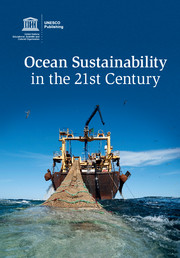Book contents
- Frontmatter
- Contents
- List of contributors
- Acronyms and abbreviations
- Foreword by Irina Bokova, Director-General of UNESCO
- Foreword by Thomas E. Lovejoy
- Preface
- Acknowledgements
- 1 Issues regarding oceans and opportunities: an introduction to the book
- 2 Main human uses of ocean areas and resources, impacts, and multiple scales of governance
- 3 Physical and chemical changes in the ocean over basin-wide zones and decadal or longer time-scales: perspectives on current and future conditions
- 4 Knowledge and implications of global change in the oceans for biology, ecology, and ecosystem services
- 5 A new perspective on changing Arctic marine ecosystems: panarchy adaptive cycles in pan-Arctic spatial and temporal scales
- 6 Ecosystem approach and ocean management
- 7 Challenges in using valuation in ecosystem-based management in a marine context: the case of UK Marine Protected Area designation
- 8 The contribution of international scientific cooperation and related institutions to effective governance for the oceans: the cases of regional tsunami early warning systems and the Argo project
- 9 Emerging and unresolved issues: the example of marine genetic resources of areas beyond national jurisdiction
- 10 The assumption that the United Nations Convention on the Law of the Sea is the legal framework for all activities taking place in the sea
- 11 The legal regime of outer space in light of the Law of the Sea
- 12 Towards sustainable oceans in the 21st century
- Index
- References
8 - The contribution of international scientific cooperation and related institutions to effective governance for the oceans: the cases of regional tsunami early warning systems and the Argo project
Published online by Cambridge University Press: 05 May 2015
- Frontmatter
- Contents
- List of contributors
- Acronyms and abbreviations
- Foreword by Irina Bokova, Director-General of UNESCO
- Foreword by Thomas E. Lovejoy
- Preface
- Acknowledgements
- 1 Issues regarding oceans and opportunities: an introduction to the book
- 2 Main human uses of ocean areas and resources, impacts, and multiple scales of governance
- 3 Physical and chemical changes in the ocean over basin-wide zones and decadal or longer time-scales: perspectives on current and future conditions
- 4 Knowledge and implications of global change in the oceans for biology, ecology, and ecosystem services
- 5 A new perspective on changing Arctic marine ecosystems: panarchy adaptive cycles in pan-Arctic spatial and temporal scales
- 6 Ecosystem approach and ocean management
- 7 Challenges in using valuation in ecosystem-based management in a marine context: the case of UK Marine Protected Area designation
- 8 The contribution of international scientific cooperation and related institutions to effective governance for the oceans: the cases of regional tsunami early warning systems and the Argo project
- 9 Emerging and unresolved issues: the example of marine genetic resources of areas beyond national jurisdiction
- 10 The assumption that the United Nations Convention on the Law of the Sea is the legal framework for all activities taking place in the sea
- 11 The legal regime of outer space in light of the Law of the Sea
- 12 Towards sustainable oceans in the 21st century
- Index
- References
Summary
8.1 Introduction
Good ocean governance through marine science and technology means promoting the use of the oceans and seas as part of efforts to ‘eradicate poverty, to ensure food security and to sustain economic prosperity and the well-being of present and future generations’ (United Nations, 2000, para. 39). Therefore, it is necessary to ensure access for decision-makers to advice and information on marine science and technology, the appropriate transfer of technology, and support for the production and diffusion of factual information and knowledge for end-users through appropriate policies.
Disaster risk reduction has since long been recognized as a fundamental contribution to development (see, recently, UNISDR and WMO, 2012) and ocean observation plays a key role in fostering the knowledge needed to manage marine resources sustainably (see, recently, United Nations, 2012c). In this light, the present contribution focuses on two interrelated issues for which an institutional framework for international cooperation and coordination has emerged, but is still incomplete and may require further guidance within existing mechanisms or the development of additional instruments. The organization of regional tsunami warning and mitigation systems (TWS), and a global framework to address ocean hazards related to sea level, entail a complex set of multilateral and bilateral arrangements for the exchange of real-time seismic and sea-level data and the issuing of advisory and warning messages across the countries of shared ocean basins (for a comprehensive review of the subject of tsunamis see Bernard and Robinson, 2009). The international Argo Project is an array of over 3500 free-drifting profiling floats that allow continuous monitoring of the temperature, salinity, and velocity of the upper 2000 m of the ocean. Both the TWS and Argo are relevant cases that prove how effective ocean governance can be achieved through the design and implementation of appropriate international scientific research and observational programmes.
8.2 Ocean observation and marine scientific research
The United Nations Convention on the Law of the Sea (UNCLOS) devotes its Part XIII (Articles 238–265) to Marine Scientific Research and its Part XIV to Development and Transfer of Marine Technology.
- Type
- Chapter
- Information
- Ocean Sustainability in the 21st Century , pp. 174 - 197Publisher: Cambridge University PressPrint publication year: 2015



